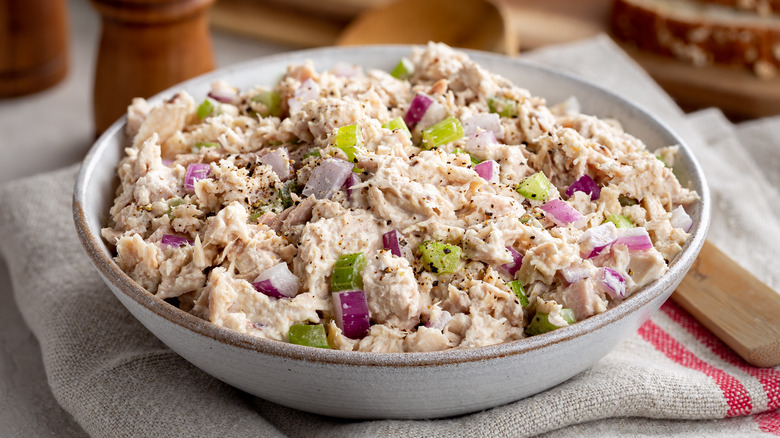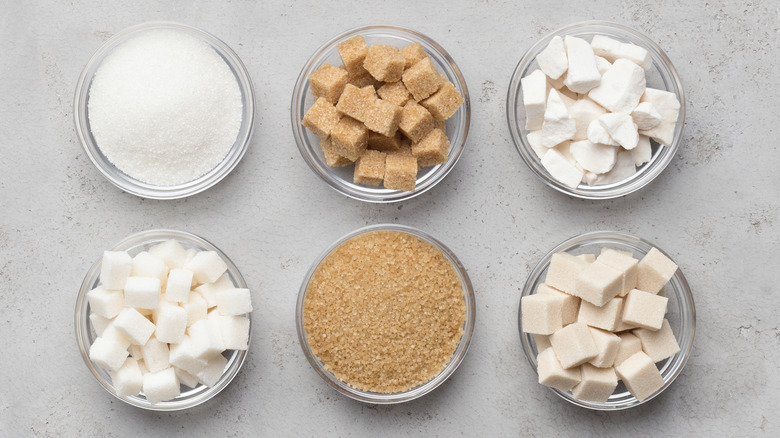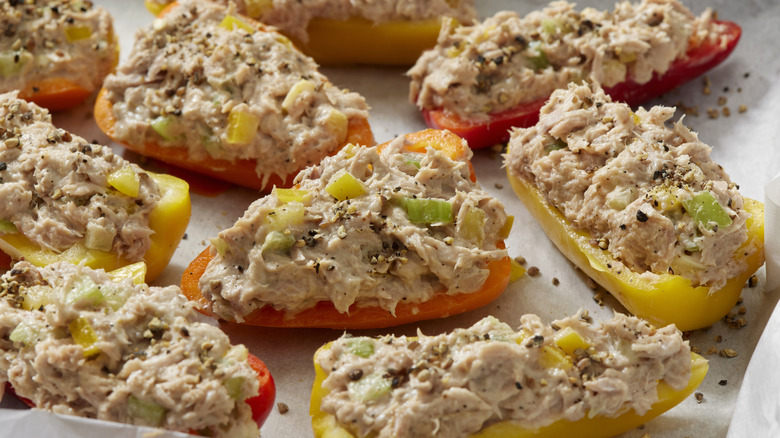A Sprinkle Of Sugar Is Your Secret For A Better Tasting Tuna Salad
A tried and true meal that's been enjoyed for over 100 years, tuna salad is a quintessential lunch fare packed with healthy fat, protein, and flavor. Although it is typically crafted from a simple combination of canned tuna, mayonnaise, celery, red onion, and a dash of lemon juice, there are dozens of ways to jazz it up. Whether you like it studded with spicy jalapeños, threaded with peppery green onion, or blended with Dijon mustard instead of mayo, there's no wrong way to craft a tuna salad. There is, however, a common kitchen ingredient your tuna salad might be missing: sugar.
We'll be the first to admit that adding sugar to tuna salad is an unconventional addition to a classic seafood dish, but trust us, it has its place. When introduced to a tuna salad, sugar acts as an equalizer by balancing its savory, salty, and acidic profiles for an evenly distributed flavor. If you end up purchasing an ultra-fishy can of tuna, sugar mellows out its intensity without imparting a cloying taste to the dish. Additionally, a touch of sugar counteracts any bitterness in pungent veggies or a particularly strong type of mustard. Not only does sugar facilitate symmetrical flavors in a tuna salad, but it also provides it with a delicate sweetness that can be likened to the taste of other dulcet ingredients commonly used in a tuna salad recipe, such as pickle relish or fruit.
Tips for introducing sugar to tuna salad
If you're not mindful, bringing sugar into your favorite tuna salad recipe can turn into a disaster. But with a few simple tips and tricks, you'll have a well-balanced medley of flavors accented by a nuanced atmosphere of sweetness. For starters, the type of sugar you use can make or break your dish. Avoid using varieties reserved primarily for baking or ultra-specific uses, such as powdered sugar and brown sugar. Powdered sugar carries a heightened sweetness, brown sugar is made with molasses, and both flaunt textures that wouldn't mix well into a tuna salad. Instead, consider using classic granulated sugar or simple syrup for swift integration and classic sugar flavors.
Start by adding a small amount of sugar to your recipe and then taste as you go. You can always add more if needed, but starting with a modest amount prevents the salad from taking on the spirit of a dessert. Instead of dumping the sugar over the final tuna salad product, consider adding it to your binding agent. Whether you opt for mayo, mustard, or Greek yogurt, adding sugar to the binder facilitates an even spread of flavor throughout the salad. If you accidentally add too much sugar, an extra hit of acid from lemon juice or apple cider vinegar can steady a cloying flavor and remedy a too-sweet batch of tuna salad.
Other ways to bring sweetness into tuna salad
Sugar is more than just a small grain of sweetness. Before it takes on that quintessential sugar form, it exists naturally in various fruits, vegetables, and syrups, which means you don't have to add refined grains of sugar to achieve a tuna salad with a well-balanced flavor profile.
Fruits are a great example of foods that possess naturally occurring sugars. Instead of using granulated table sugar or simple syrup, mix in pineapple and mango for a tropical and oceanic take on a tuna salad, or introduce diced apples for a sweet and juicy crunch. Of course, you can never go wrong with dried cranberries for a tart and chewy twist. Although they're not quite as sweet as fruit, some sugary vegetables like crunchy shredded carrots, colorful bell peppers, and cherry tomatoes can also provide your tuna salad with a more muted hint of sweetness. If you want to avoid altering the texture of your tuna salad recipe, consider adding a small amount of smooth, sugary syrups like honey, agave nectar, or maple syrup for seamless integration and floral, woody shades of sweetness.
Whether you opt for liquid sugar, granulated sugar, or organic sugars found in fresh produce, bringing a hint of sweetness to your tuna salad is an easy way to take it from ordinary to extraordinary. Trust us, once you try it, you might never go back to your old ways.


